introductory
Gout is known as the "immortal cancer", which is categorized as "paralysis" in traditional Chinese medicine (TCM). This article analyzes the tongue diagnosis of two typical cases to reveal the core logic of Chinese medicine's diagnosis and treatment. It is proved that after mastering the tongue diagnosis technique, ordinary enthusiasts can also accurately recognize the symptoms and lay the foundation for subsequent treatment.
I. Control analysis of tongue diagnosis of cases
Case 1: 57-year-old male (gout 20 years)
Male, 57 years old, gout for more than 20 years, eat seafood, peanuts, chicken soup and other high soup, gout attacks. Every time I have an attack, the back of my left foot and ankle are red and painful, but not swollen. When it is serious, she can't get out of bed. High blood pressure for 3 years, has been controlled with medication. Multiple phlegm nuclei all over the body, as big as egg yolk. Yellow and frothy urine, normal stools, 1-2 days. Sleeps well, good health. Likes heavy flavored food.
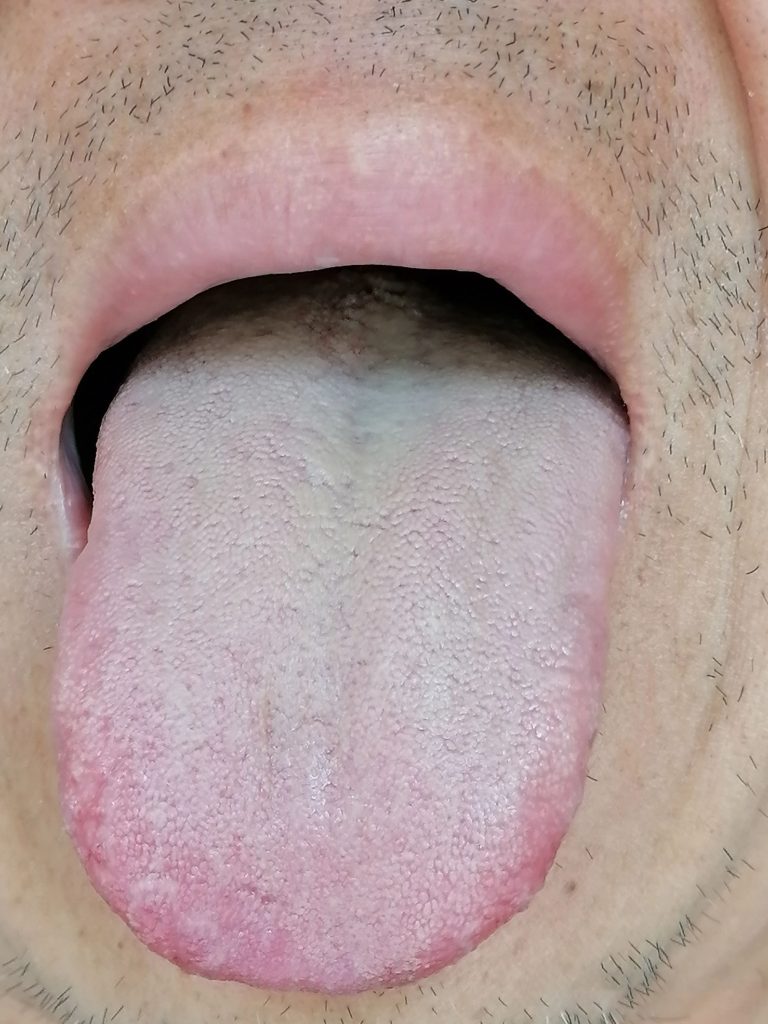
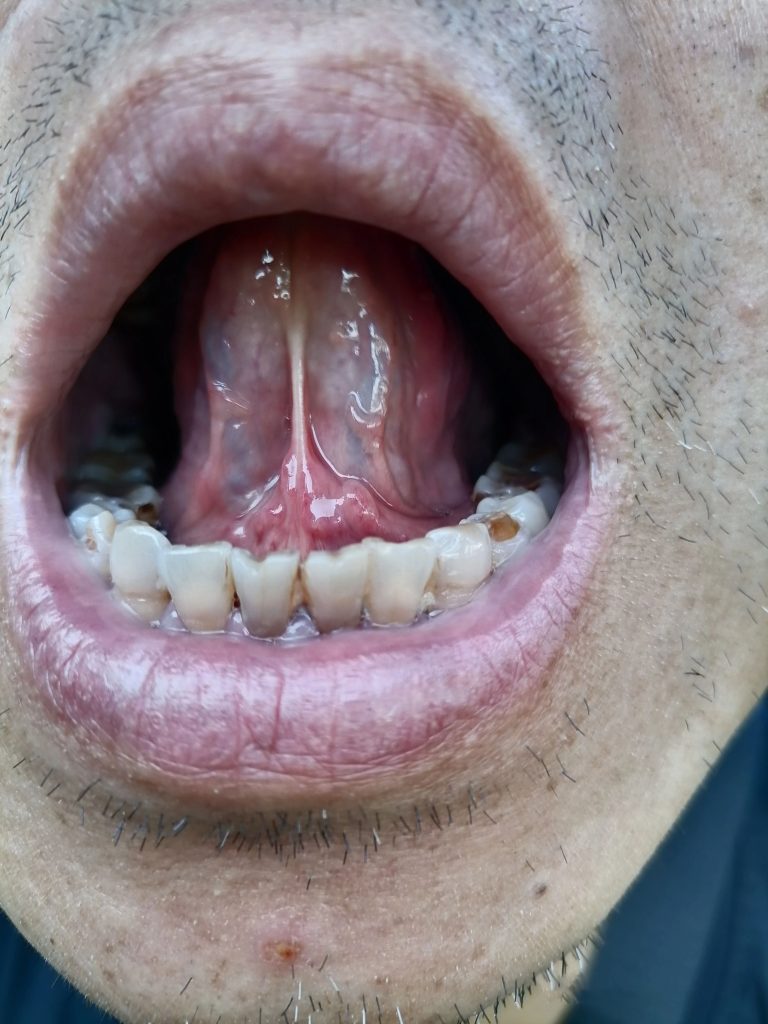
Tongue Characteristics::
- blade of tongue: Short, shrunken and strong: the tongue is short and difficult to stretch freely, but a sense of strength is still present. Yellow and greasy tongue moss from the middle to the root of the tongue: A yellow and greasy layer of tongue moss covers the area from the middle to the root of the tongue.
- blade of tongue: Pale reddish dark: the overall color of the tongue is pale red, but slightly dark. Visible teeth marks on the edge of the tongue: there are clear teeth marks on the edge of the tongue, as if they have been gently bitten by teeth.
- crackles: Longitudinal fissure in the middle of the tongue extending to the root of the tongue: there is a longitudinal fissure in the middle of the tongue which extends from the middle of the tongue to the root area.
- sublingual veins (medicine): The veins are straight and long without bifurcation: the sublingual veins are straight and without bifurcation.
key points of diagnosis::
- malingering of cold and heat: White tongue moss in the upper burner is cold, while yellow greasy tongue moss in the middle and lower burner is damp-heat: white tongue moss in the front part of the tongue indicates cold in the upper burner; while yellow greasy tongue moss in the middle and root shows damp-heat in the middle and lower burner.
- stagnant qi (TCM): Depression in the midline of the tongue suggests that the elevation of the spleen and stomach is out of order: Depression in the middle of the tongue suggests that there is a disturbance in the normal function of the spleen and stomach to elevate and lower the turbidity.
- accumulation of phlegm and stasisCracks and teeth marks reflect phlegm-dampness that has accumulated for a long time and become stasis: Cracks and teeth marks on the tongue indicate that phlegm-dampness that has accumulated for a long time in the body has gradually formed stasis.(Previous Review: Analysis of the Root Cause of Ice-covered Tongue: The Tongue Code of Yang Deficiency and Cold Congealment with 14 Practical Diagrams)
Tongue diagnosis is to observe the color and structure of the tongue to discover the patient's body condition of cold and heat, qi, deficiency and solidity, blood stasis and blood circulation, and to better corroborate the symptoms described by the patient through the internal mechanism so as to further accurately dispense prescriptions and medications.
In tongue diagnosis, weFirst look at the whole, i.e., yin and yang and reality, grasping the general direction not to be wrong. This patient stretches the tongue forcefully, flat, suggesting that the essence is not false, may just be the evil by the depression.
Next, look at the heat and cold.Cold and heat can be seen from the color of the tongue coating, the range of distribution, dryness and wetness, as well as the morphology of the tongue. In this case, the patient's moss is full, white and thin in the upper part, gradually becoming thicker in the middle and starting to be slightly yellow, thick and greasy yellow in the Large Intestine and the Lower Jiao, and there is also dryness and wetness transitioning also from the top to the bottom, and the tongue suggests that the whole is the process of transforming Damp-Cold to Damp-Heat.
Third look at the chiQi is mainly analyzed through the shape of the tongue, and the changes in the shape of the tongue are related to the contrast of the strength of the qi in each part of the body; therefore, especially in patients with long-term chronic diseases, the shape of the tongue will become irregular in most cases. In this case, the depression of the midline of the tongue and the teeth marks on both sides of the tongue suggest that the spleen and stomach in the middle jiao are weak, and the transportation and digestion are weak, and the depression on the right side of the tongue and the imbalance of the midline suggest that the liver and gallbladder qi are not smooth, and the main reason may be that the gallbladder qi is not descending. The bulging at the root of the tongue suggests that the lower Jiao is severely obstructed by dampness leading to the depletion of kidney yang, which is probably also the root cause of dampness turning into heat. Manifestations of yellow urine, gout occurring at the location of the Gallbladder meridian (about the foot Linsui), etc.
Fourth, look at the blood stasisBlood stasis is usually recognized by the presence of petechiae and ecchymosis on the tongue and the veins under the tongue. The presence of petechiae or ecchymosis on the tongue suggests that there may be blood stasis in the internal organs. In this case, the veins under the tongue grow straight from bottom to top without bifurcation, indicating that the blood stasis reflects the obstruction of the blood system, such as high blood pressure.
Fifth, look at the water drinkThe patient's tongue shape is also a good indicator of the state of water retention in the body. It is also necessary to view the state of water retention in the body through the shape of the tongue, especially the whole tongue or localized bulging (fat and thick), which is not clearly characterized in this case.
Comprehensive analysis showed that the patient in this case had deficiency of yang depression and spleen, and was weak in transportation and digestion. The patient's yang was not deficient, but it was blocked by dampness and transformed into heat, therefore, eating foods that were heavy in dampness and turbidity would cause gout. When the dampness and turbidity are not transformed for a long time, the dampness and heat fight with each other, refining the fluid into phlegm, so there are multiple phlegm nuclei all over the body.
Case 2: 33-year-old male (gout for 2 years)
1. Male 33 years old
2, the body tired, sleepy, listless, do nothing active, muddled, sleep recently can be, sometimes good and sometimes bad;
3, afraid of heat during the day , sleep at night afraid of cold, easy to sweat, sweat is not afraid of the wind;
4. Dry mouth without bitterness, love to drink water;
5. Normal stools, yellow urine with foam;
6. Fatty liver, high uric acid. Tinnitus in the right ear, occasional tinnitus in the left ear, tinnitus for 10 years, tinnitus midway through the visit, glutathione, ginkgo biloba drops and so on have no effect;
7, gout for 2 years, left thumb joint soreness, daily diet easy to overeat, spleen and stomach digestion function is weak, digestion is slow, cold things can not eat, love sweating (especially dinner) usually sedentary, work pressure.
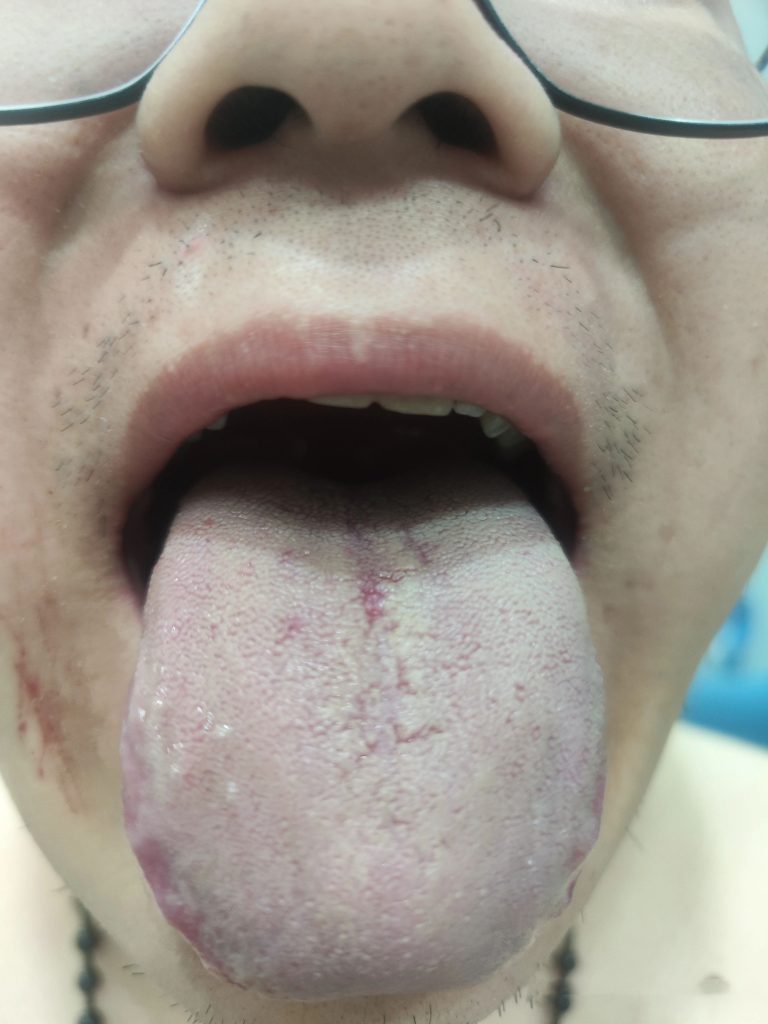
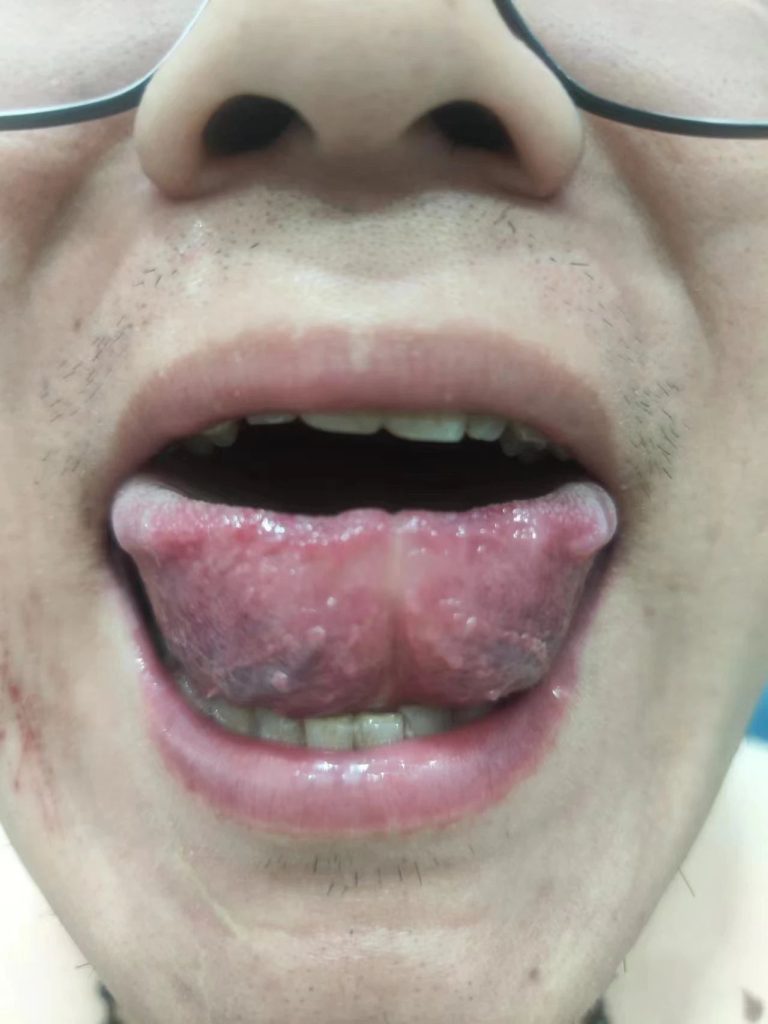
Tongue Characteristics Analysis
(i) Identify cold and heat
The tongue is covered with thick, white, yellow and moist tongue moss, which indicates that the cold and dampness in the body is relatively heavy and has been gradually transformed into heat.
(ii) Defend the real and the imaginary
A tongue that appears fat and tender, or even feels weak when stuck out, is usually a sign of deficiency, indicating a lack of overall energy and vitality in the body.
(iii) Discriminating between the surface and the interior
Tongue moss is so thick that you can't see the original color of the tongue, which indicates that the disease has penetrated deep into the body, and the condition is relatively serious, belonging to the internal evidence.
(iv) Analyzing Phlegm and Drink
The tongue is covered with moist thick moss, and the tip of the tongue looks bulging with obvious teeth marks around the edges, which indicates that there is accumulation of phlegm and drink in the body, and that the phlegm-dampness evil has caused obstruction in the upper jiao position.
(E) Identifying Qi, Qi and Blood
- If the root of the tongue is in a tightened state and is slightly concave in the middle and lower jiao, this implies a deficiency of yang in the spleen and kidneys. The yang energy of the spleen and kidneys is insufficient to properly perform its role of warming and promoting bodily functions.
- When there is asymmetry on both sides of the tongue, this indicates that the qi is not running smoothly. The elevation and movement of qi in and out of the body is disorganized, resulting in obstruction of qi and blood operation.
- If the texture of the tongue moss in the middle and lower Jiao gradually becomes dry and appears to be finely cracked and granular, this is most likely a manifestation of Yin deficiency in the Spleen and Kidneys, which turns into Heat, and Damp-Heat precipitates downwards. Insufficient Yin and fluid in the Spleen and Kidneys results in the internalization of Deficiency-Heat, while at the same time the Damp-Heat Evil precipitates downwards.
(vi) Defining Bruised Blood
A dark red color under the tongue and on both sides of the tip of the tongue, and the length of the veins under the tongue is more than one-half of the tongue, suggesting the presence of Qi stagnation and blood stasis in the body. Qi and blood do not run smoothly, and blood pools in the veins, forming stasis.
first impression
Taken together, this condition is initially characterized by weakness of both yin and yang of the spleen and kidneys, accumulation of water-dampness in the body, and downward precipitation of dampness-heat evils, as well as poor qi and blood circulation, resulting in qi stagnation and blood stasis.
Second, the core logic of gout Chinese medicine identification
1. The three elements of pathogenesis
- (i) Dampness and turbidity
- tongue presentation : Thick, greasy tongue coating covering the tongue.
- positivity rate : Present in patients with 93%.
- pathological explanation This indicates that the accumulation of dampness and turbidity in the body is mostly due to the dysfunction of the spleen's transport function, which is unable to properly transport water and dampness, leading to the accumulation of dampness and turbidity in the body.
- (ii) Qi imbalance
- tongue presentation : Abnormalities in the shape of the tongue, such as a fat, shortened, or crooked tongue.
- positivity rate This condition exists in patients with: 86%.
- pathological explanation : This indicates that the body's qi is not running smoothly, and the lifting and lowering of qi is disorganized, which affects the normal functioning of the internal organs.
- (iii) Phlegm and blood stasis interconnections
- tongue presentation : Abnormalities in the sublingual channels, such as dark color, tortuousness, and thickening.
- positivity rate : Abnormal sublingual choroid in patient with 72%.
- pathological explanation : This suggests that phlegm-dampness and blood stasis are intertwined in the body, obstructing the flow of qi and blood and leading to blockage of the meridians.
2. The four-step approach to evidence identification
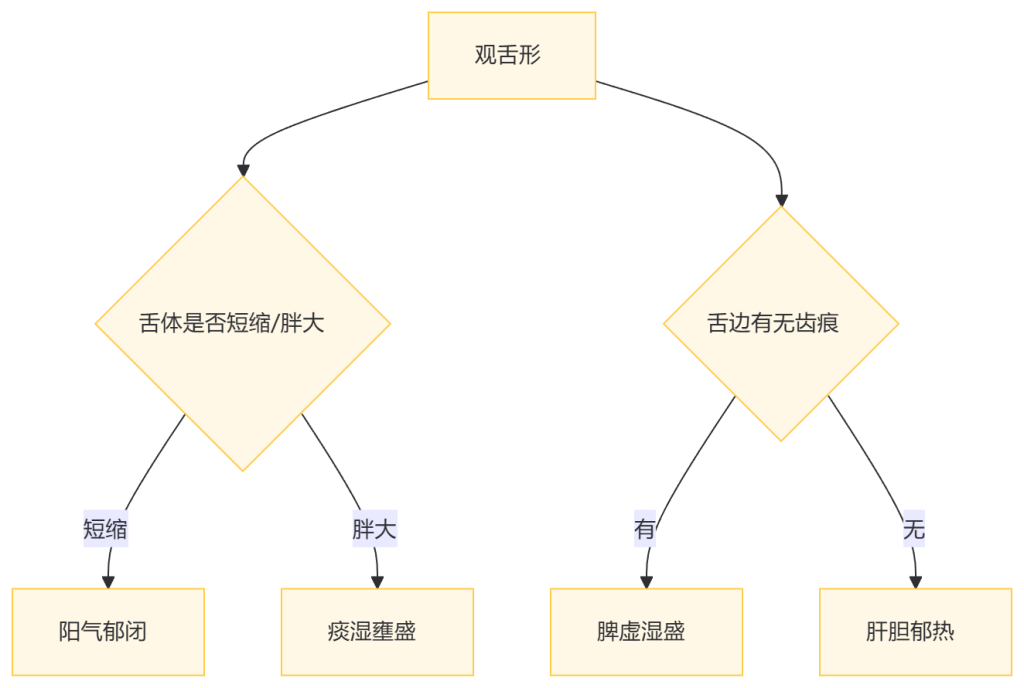
3. Key points of identification in the acute and chronic phases
| point | Tongue Characteristics | treatment direction |
|---|---|---|
| acute phase | Yellow, thick and greasy tongue coating + red tongue | Clearing heat and removing dampness, promoting circulation and relieving pain |
| remission period | White and greasy tongue coating + dark tongue texture | Warming Yang, removing dampness, activating blood circulation and removing blood stasis |
4. Characteristics of tongue diagnosis for gout
1. Fundamental: Deficiency of the spleen and kidney, internal stoppage of water and beverages, and failure of qi to descend.Tongue shape - wide at the top and narrow at the bottom, swollen and fat at the top and narrow at the bottom; depression in the tongue suggests spleen deficiency. Tooth marks on the edge of the tongue, weakness of Ying and Wei, and easy pain in the limbs.
2. Acute stage: from plain cold and dampness, to dampness and heat.Tongue thick and greasy, some color yellow, some color white, usually more yellow color, or local color yellow, the patient in today's case is a full tongue thick and greasy yellow.
3. Internal heat is fundamental.The tongue is red but edematous, so although there is heat, there is also water, so the patient is afraid of external dampness, and any factor that increases water-dampness will aggravate the organism's condition, and it is easy to turn heat into heat, which is known as more severe damp-heat (heavy inflammatory response in Western medicine).4. Qi stagnation and blood stasis.
The sublingual veins tend to be more raised, dark in color, and long; this is not a major factor.
Summarize: external dampness-heat + internal heat + kidney deficiency + spleen deficiency + weak Ying and Wei. III.Thoughts on Treatment Ideas:
1, the site decided that the disease is closely related to the kidney
Gout pain sites are joints, and generally in the joints we say that they are closely related to the kidneys;
2. Spleen deficiency is the key, the rootSpleen ability to transport water and dampness is weak is very important, so the patient to eat without attention is the tongue thick and greasy, which is similar to many patients with renal failure, but renal failure is mostly tongue thick and greasy color white, belonging to the external cold and dampness, but this gout in the acute stage, inflammation is strong, indicating the presence of heat is strong, so the patient is mainly tongue thick and greasy yellow; so the treatment should not be tonifying the kidneys, it should be aroma to transform dampness and strengthen the spleen, warming the kidneys and drying dampness to select the Epiphyllum, this is the root.
3. Weakness of Yingwei is an important factor
Weakness of Ying and Wei, external evils are easy to attack, this is an important factor, patients usually start to hurt at night, this pain is related to weak Wei and poor defense, so Gui Zhi Tang is a commonly used drug.
4. Summary
From a certain point of view, everyone who is plainly able to well strengthen the spleen and dispel dampness, warm the kidney and dry dampness, aroma and dampness, clear heat and dry dampness of the prescription medicines used skillfully, the treatment of gout are more effective.
III. Scripture Application and Improvement Program
1. Classical formulae in the acute phase
Si Miao Yong An Tang combined with Gui Zhi Paeoniae Zhi Mu Tang
- formula30g of Honeysuckle, 20g of Xuan Shen, 15g of Angelica Sinensis, 12g of Gui Zhi, 18g of Paeonia lactiflora.
- add or subtract::
- the pain is aggravatedFrankincense and myrrh6g each
- Fever plusgypsum CaSO4-2(H2O)30g (decoction first)
2. Modified mitigation options
Radix Rehmanniae Praeparata Soup combined with Radix Angelicae Sinensis Paeoniae Radix
- formula9g of Radix et Rhizoma Polygoni Multiflori (decocted first), 15g of Radix et Rhizoma Polygoni Multiflori, 30g of Rhizoma Atractylodis Macrocephala, 20g of Poria
- Compounding Points::
- Enhancing Warming Yang and Resolving Dampness with Radix et Rhizoma Ginger
- Poria cocos with zedoary to enhance diuresis and seepage of dampness
3. conditioning
1, why patients with acute acute attacks of gout, very closely related to diet?
Because the patient is usually weak in the kidneys and spleen, so once the patient takes damp-heat medication, the organism can not excrete these wastes well, and the problem of damp-heat will be formed, and the acute attack of gout will occur.2. Why the acute attack site is in the bone jointsKidneys are responsible for bone marrow production, weak kidneys, joints and bones and other parts of the drainage of water and drink role is also poor, so the accumulation of disease waste, mainly in the vicinity of the joints and bones;
3、Why are seizures often accompanied by superficial evidence
These patients have weak camps and guards, mainly the guards are weak, so the patients are susceptible to the onset of illness by the wind, with problems such as fever and malignant chills, and these problems are the epiphenomena mentioned in the theory of typhoid fever, which are mainly caused by the weakness of the guards' qi.
4, cold dampness into heat is the rootSo the food that transforms heat should not be eaten, such as seafood, mutton, beer, etc., are prone to the problem of transforming heat into cold and dampness, mainly because the dampness and heat can not be discharged from the body, and these dampness and heat rapidly accumulate to the joints.
5. Ordinary health care
Spleen and kidney deficiency is fundamental, so the plain needs to be treated by strengthening the spleen and resolving dampness, warming the kidneys and drying dampness, and keep treating until there is no thick and greasy tongue, and must be eaten sparingly during the stage of spleen and kidney deficiency.
Moderate exercise is very critical, acute stage can not exercise, but plain exercise, can strengthen the spleen to dispel dampness, so the non-acute stage of pain, adhere to eat less light food, and adhere to exercise is very important.
Four, tongue diagnosis practice teaching points
1. Three steps to recognize heat and cold
- A holistic view: Tongue color light red is normal, bright red is hot, light white is cold.
- local comparisonRed tongue tip is Heart Fire, yellow tongue root is Lower Jiao Damp-Heat.
- dynamic change: The change of the moss from yellow to white after taking the medication suggests that it is heading towards healing.
2. Five Steps to Recognize Qi Mechanisms
- Tongue morphology: shortness is associated with depression and closure; bulkiness is associated with phlegm-dampness.
- Tongue border features: Heavy teeth marks indicate a deficiency of the spleen, while awn thorns indicate an excess of heat.
- Tongue moisturizing and drying: Dryness and lack of fluid is a deficiency of yin, while smoothness and wetness is a deficiency of yang.
concluding remarks
This article verifies the core value of tongue diagnosis in gout diagnosis through typical case analysis. Mastering the four-step method of "tongue diagnosis", together with the prescription, can make gout treatment twice as effective with half the effort. It should be emphasized that the prescription in this article should be used after identification by a licensed Chinese medicine practitioner, and the combination of Chinese and Western medicine should be used in time for the acute attack.


Leave a Reply